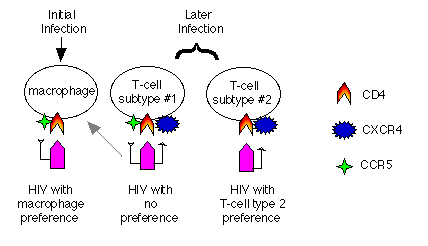
The protein molecule on the surface of the Th cell to which HIV binds is called CD4. (Immunologists have complicated ways of naming things, so this name doesn't stand for anything very meaningful.) HIV will bind to any cell that bears CD4 in its membrane. This includes Th, macrophages and some supporting cells in the brain. However, the story is more complicated than this. CD4 is necessary for HIV binding, but not sufficient. For example, if the gene for human CD4 is transfected into monkey COS cells, HIV will not infect these COS cells. During the summer of 1996, several research teams (read lots of people working cooperatively in the labs) made significant progress in understanding HIV infection (Science 272:1740, June, 1996). There are at least two types of molecules (coreceptors) that are also required for HIV infection: fusin and CC-CKR-5 (such a catchy name). As shown in the figure below, HIV requires cells to have CD4 and either fusin or CC-CKR-5 in their plasma membranes. Fusin had been cloned previously but its function was unknown. It is a G protein-coupled receptor for an unknown ligand. CC-CKR-5 is a receptor for the cytokine RANTES. (Cytokines or lymphokines are chemical messengers secreted by the immune system and the significance of RANTES will be discussed later. ) What is especially interesting is that there are different strains of HIV that infect different types of CD4+ cells. One strain infects marcophages and another strain prefers T-cells. As it turns out, macrophages express CC-CKR-5 and T-cells express fusin. It has been known for years that when a person is first infected with HIV, the macrophages get infected first. A plausible explanation is that the stain of HIV that is responsible for its spread requires CC-CKR-5 as a coreceptor and not fusin. As the infection spreads, HIV is able to infect T-cells which means it requires fusin as the coreceptor. These discoveries are very recent so their impact is uncertain, but they do help explain much about HIV infection.

As is the always the case, these membrane proteins that bind viruses are not in the membrane for that purpose (this certainly would not be adaptive.) Rather, they are there for some other purpose, and the virus exploits their presence to gain entry into the cell. CD4 is one of the molecules that allows Th to bind to antigen in order to become activated. Figure 39.13 illustrates the pivotal role of Th (also called CD4+ cells.) CD4 is an integral membrane protein on the surface of the helper T cell and interacts with the Class II MHC, T-cell receptor, and antigen. It stabilizes the interaction of these three molecules.
© Copyright 2000 Department of Biology, Davidson College, Davidson,
NC 28036
Send comments, questions, and suggestions to: macampbell@davidson.edu